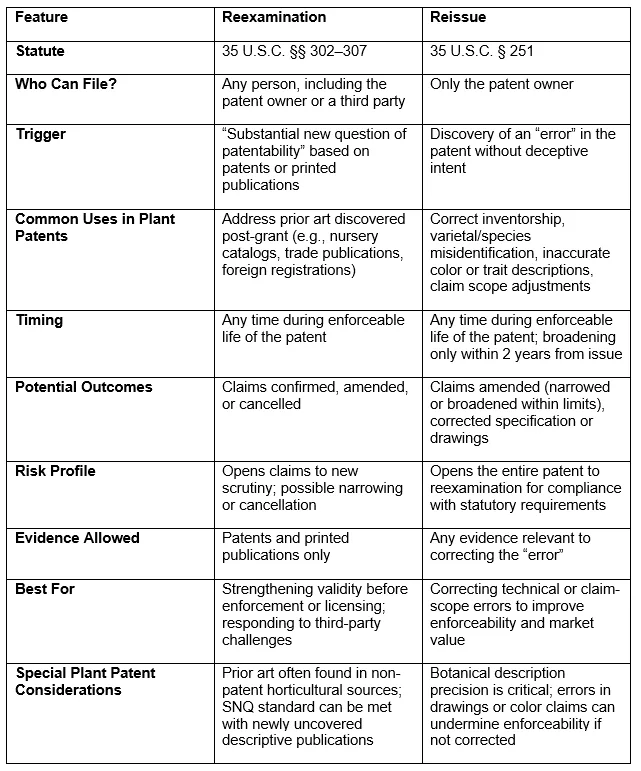As plant innovation moves into a new era—driven by climate adaptation, consumer preferences, and advanced breeding techniques—most attention on plant patents focuses on securing the initial grant. Yet, in rare instances, plant patents have been revisited through post-grant mechanisms: ex parte reexamination and reissue[1]. At the time of writing, only a handful of plant patents have gone this route, but as the commercial stakes rise for high-value cultivars, this path deserves more attention. In this article, we explore the legal and practical limits for plant patents and why this may be a strategic option for innovators and owners.
The Rarity of Post-Grant Action in Plant Patents
Since the Plant Patent Act of 1930, plant patents have provided a narrow but important form of protection for asexually reproduced plant varieties. Unlike utility patents, they cover a single claimed plant and its clones. Because of their specificity, and the unique challenges in documenting prior art, post-grant proceedings like reexamination and reissue have been almost unheard of in the plant patent space.
Nonetheless, as plant patents become increasingly valuable in mergers & acquisitions (M&A), licensing, and international plant breeder’s rights portfolios, revisiting an issued plant patent may offer strategic value. Post-grant mechanisms can be used to correct errors, strengthen claims, or address overlooked prior art. For businesses seeking certainty in their IP rights, these tools may transform a vulnerable patent into an enforceable, reliable asset.
Defining “New” in Plant Patent Reexamination
In the utility patent context, the “new” requirement for substantial new question of patentability (“SNQ”) has evolved through legislative amendments and case law as explored in our June 2024 article. For plant patents, the stakes are different:
- Plant-specific prior art may include nursery catalogs, trade publications, plant variety registration databases, or non-patent literature from horticultural societies.
- Challenges emerge because much of this art may not be digitized, meaning previously overlooked material can surface decades after a patent grant. Additionally, visual traits, including photographs, drawings, and color claims, may be open to subjective interpretation over time.
In practice, the “new” threshold for plant patents will often turn on whether the plant or its defining traits were documented in a way that could reasonably have been found and considered during the original examination.
Known Cases and Lessons
Only a few plant patents have been publicly documented as having undergone reexamination or reissue, but these examples provide meaningful insights:
- Proactive Owner Action: In some cases, patentees themselves initiated proceedings to fix descriptive errors or strengthen claims, anticipating enforcement or licensing disputes.
- Third-Party Initiated Challenges: Competitors sometimes initiated reexamination after uncovering relevant prior art in trade catalogs or foreign plant registration records.
From these, several lessons emerge:
- Detailed trait documentation—such as color stability, branching habit, and bloom duration—can help defend against later challenges.
- Correcting even small descriptive errors matters. Inaccurate color designations or varietal identifiers could otherwise undermine enforceability.
- Third-party cataloging of cultivars creates a shifting prior art landscape. As databases expand and digitization progresses, older patents may face new scrutiny.
Strategic Considerations for Plant Innovators
Given these dynamics, plant patent owners should treat post-grant proceedings as a strategic option rather than a last resort.
- When to Consider Reexamination or Reissue:
- In preparation for licensing negotiations, where counterparties may raise validity questions.
- Before asserting a patent in litigation, to mitigate risk of invalidation.
- Upon discovering prior art that could undermine validity, ensuring proactive correction.
- To correct formal defects such as inventorship or descriptive inconsistencies that could become enforcement issues.
- Risks:
- Reexamination and reissue open claims to further scrutiny, with potential narrowing of scope or even cancellation.
- A reissue proceeding, in particular, reopens the entire patent to statutory review, creating risk of loss if the USPTO and applicant cannot agree.
- Opportunities:
- Successfully navigating post-grant proceedings can strengthen claim position, increasing confidence for enforcement and licensing.
- A corrected or reinforced patent may carry greater market credibility, particularly for high-value ornamental or fruit cultivars.
- Coordinating reexamination or reissue with complementary utility patent coverage can align protection strategies across an IP portfolio.
Conclusions and Takeaways
Given the rarity of reexamination and reissue in plant patents, the space presents an opportunity for strategic use. As cultivar innovation accelerates, the value of a patent often extends far beyond its grant date. Properly used, post-grant proceedings can ensure that the IP covering a high-value plant remains an asset rather than a liability.
- Awareness Gap: Many plant innovators and even IP professionals overlook post-grant USPTO procedures for plant patents.
- Opportunity: Corrective or strengthening action via reexamination or reissue can enhance enforceability and licensing value.
- Action Item: Patent owners should periodically audit their plant IP portfolios for accuracy, scope, and resilience against newly surfaced prior art.
As we have noted, plant patents already represent a unique intersection of horticultural beauty and legal protection, designed to encourage innovation and investment in plant breeding.[2] Extending this mindset to include post-grant strategy may prove crucial as the commercial and competitive importance of cultivars grows.
Reexamination vs. Reissue for Plant Patents – Quick Reference Guide

[1] The basis of reissue and reexamination were explored in previous articles, including April 2024.
[2] An overview of plant patents was covered in previous articles, including September 2024.